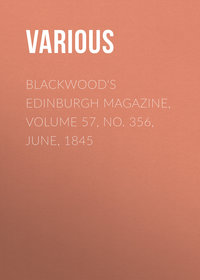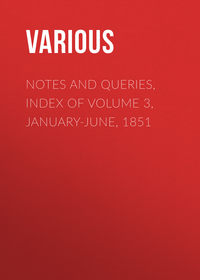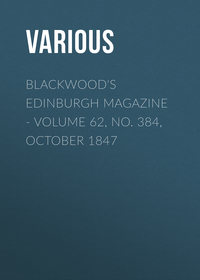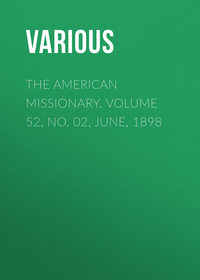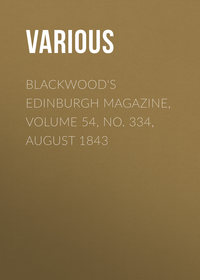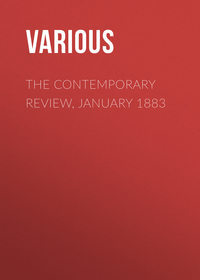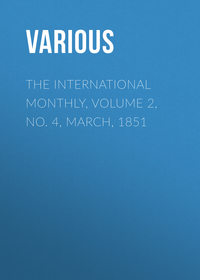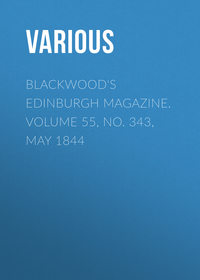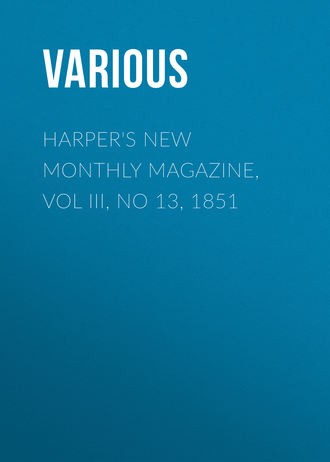 полная версия
полная версияHarper's New Monthly Magazine, Vol III, No 13, 1851
Powers, writing from Florence, thus describes the statue of California, upon which he is engaged: "I am now making a statue of 'La Dorado,' or California, an Indian figure surrounded with pearls and precious stones. A kirtle surrounds her waist, and falls with a feather fringe down to just above the knees. The kirtle is ornamented with Indian embroidery, with tracings of gold, and her sandals are tied with golden strings. At her side stands an inverted cornucopia, from which is issuing at her feet lumps and grains of native gold, to which she points with her left hand, which holds the divining rod. With her right hand she conceals behind her a cluster of thorns. She stands in an undecided posture – making it doubtful whether she intends to advance or retire – while her expression is mystical. The gold about her figure must be represented, of course, by the color as well as the form. She is to be the Genius of California."
Mr. Whitney, the projector of the railroad to the Pacific is now in London to urge upon Government to undertake the construction of the road through the British possessions.
Mr. Gilbert, Member of Congress from California, himself a printer, has presented to the Typographical Society of New York a double number of the Alta California newspaper, printed upon white satin in letters of gold.
The Philadelphia Art Union has contracted for an original painting by Rothermel, which is to be engraved for distribution to its subscribers the present year. It has likewise provided a portfolio of sketches from which subjects for commissions may be selected. The plan of this Association differs from that of the Art Union of this city, in that it distributes prizes, not pictures, allowing those who draw the prizes to select their own subjects.
Chilly McIntosh, head war-chief of the Choctaw nation, has been ordained as a clergyman, and is now preaching in connection with the Baptist Board.
Sir Charles Lyell has delivered a Lecture before the Royal Institution on Impressions of Rain drops in Ancient and Modern Strata. These impressions were first observed in 1828, by Dr. Buckland. A close analogy was discovered between the impressions on the rocks, and those made by showers of rain upon soft mud. In conclusion, the lecturer remarked on the important inferences deducible from the discovery of rain-prints in rocks of remote antiquity. They confirm the ideas entertained of the humid climate of the carboniferous period, the forests of which we know were continuous over areas several miles in diameter. The average dimensions of the drops indicate showers of ordinary force, and show that the atmosphere corresponded in density, as well as in the varying temperature of its different currents, with that which now invests the globe. The triassic hail (indicated by indentations deeper than those made by rain-drops) implies that some regions of the atmosphere were at this period intensely cold; and, coupled with footprints, worm-tracks, and casts of cracks formed by the drying of mud, which were often found upon the same slabs, these impressions of rain clearly point to the existence of sea-beaches where tides rose and fell, and therefore lead us to presume the joint influence of the moon and the sun. Hence we are lead on to infer that at this ancient era, the earth with its attendant satellite was revolving as now around the sun, as the centre of our system, which probably belonged then as now to one of those countless clusters of stars with which space is filled.
John Chapman, Manager of the Peninsular Railway Company in India, has published a pamphlet on the supply of cotton which India may be made to furnish, in which he undertakes to show, that cotton of a quality which can be used for three fourths of the manufactures of England, such as is worth there from three to five pence a pound, can be produced in any required quantity for from one and one-fourth to one and three-fourths of a penny per pound. He says it is the difficulty of transportation which prevents the extensive culture of cotton in India.
M. Eoelmen, the director of the National Porcelain Manufactory of Sèvres, has succeeded in producing crystalized minerals, resembling very closely those produced by nature – chiefly precious and rare stones employed by jewelers. To obtain this result, he has dissolved, in boric acid, alum, zinc, magnesia, oxydes of iron, and chrome, and then subjecting the solution to evaporation during three days, has obtained crystals of a mineral substance, equaling in hardness, and in beauty, and clearness of color, the natural stones. With chrome M. Eoelmen has made most brilliant rubies, from two to three millimetres in length, and about as thick as a grain of corn. If rubies can be artificially made, secrets which the old alchymists pursued can not be far off.
OBITUARIES
Philip Hone for many years an eminent merchant and prominent citizen of New York, died May 8, in the 71st year of his age. Having at an unusually early period accumulated what he regarded as a competent fortune, he withdrew from the distinguished mercantile house of which he was one of the founders, and devoted his time and means to intellectual pursuits, dignified and generous hospitality, and the promotion of all enterprises designed to benefit and honor the city, of which he was proud to be a citizen. Possessed of a warm and social disposition, a ready wit, great intelligence, and no ordinary acquirements he gathered around him a fine library and beautiful works of art, without ever withdrawing his interest from public affairs. In 1825-6 he was chosen mayor of New York, and discharged the duties of that post with a decision, energy, and promptitude which have rarely been equaled. But his most useful services to the community were in connection with various associations formed for the public good. He was president of the first Bank for Savings, and one of the original Board of Trustees, of which there are now only three surviving members; and one of the earliest and most efficient friends of the Mercantile Library Association. A marble bust of him, which adorns the library of that noble institution, sculptured at the request of the members, testifies to their appreciation of his character and services. Some few years since his fortune was considerably impaired by pecuniary reverses, which befell a near relative; and, although Mr. Hone was not legally responsible for his obligations, his high sense of mercantile honor impelled him to discharge them in full. At the accession of General Taylor, Mr. Hone was appointed Naval Officer of the port of New York, which office he held at the time when, beloved, prized, and honored by all who knew him, having honorably maintained through life the character of an high-minded American merchant, he sank to rest calmly and in full possession of his faculties.
Commodore James Barron, Senior Officer in the United States Navy, died at Norfolk, Virginia, April 21, at the age of 83 years. He commenced his naval career under the auspices of his father, who commanded the naval forces of the Commonwealth of Virginia during the Revolutionary War. In 1798 young Barron entered the navy of the United States, with the rank of lieutenant, and served in the brief war with France. In the year following he received his commission of captain, and was ordered to the Mediterranean. In 1807, going out as commander of the Mediterranean squadron, he was on board the frigate Chesapeake, when she was treacherously attacked, in a time of profound peace, in our own waters, by a British vessel of superior force. He was acquitted by a court martial, from all blame in the affair. His subsequent services were rendered on shore, mostly at Philadelphia and Norfolk. He early acquired the reputation of one of the most accomplished and efficient officers in the service. He originated the first code of signals introduced into the American navy.
David Daggett, LL.D., late Chief Justice of Connecticut, died April 12, aged 86 years. He was born in Attleboro, Mass., on the last day of the year, 1764. After graduating at Yale College, he studied law, and was admitted to the bar in 1786. In 1791 he was elected to the House of Representatives of the State, of which he was chosen Speaker in 1794, at the early age of 29. He continued a member of one of the Legislative Houses almost constantly till 1813, when he was elected to the Senate of the United States. In 1824 he was chosen Kent Professor of Law in Yale College, which post he continued to occupy until the infirmities of age compelled him to resign. In 1826 he was appointed Associate Judge of the Superior Court of the State by a Legislature, a majority of whom were opposed to him in politics. Six years after he was made Chief Justice of the Supreme Court. This office he held until December, 1834, when, having reached the age of 70 years, he vacated it in accordance with the provisions of the Constitution. Thus for forty years, from the close of his 26th to the completion of his 70th year, was Mr. Daggett almost continually engaged in public service.
Hon. William Steele died at Big Flats, Steuben County, N.Y., on the 4th of April. He was born at New York in 1762, and was actively engaged during the closing years of the Revolution. In 1780 he was on board the gun-ship Aurora, which was captured by the British brig Iris, bearing the news of the surrender of Charleston to the British. On this occasion he was severely wounded, and detained a prisoner of war for some months. In 1785 he was appointed clerk in the Treasury Board. In 1794 he commanded a troop of horse which took part in the suppression of the Pennsylvania Insurrection. He resided in New Jersey till 1819, when he removed to the western part of the State of New York.
Gen. Hugh Brady, one of the oldest officers in the army of the United States, was killed at Detroit by a fall from his carriage, at the age of 80 years. He was born in Northumberland County, Penn., and entered the army in 1792, as an ensign. In 1812 he was appointed Colonel of the 22d Infantry. At battle of Chippewa his regiment was almost annihilated and he himself severely wounded. He received the rank of brevet Brigadier-General in 1822. During the disturbances in Canada he did much to preserve the peace of the frontier. A few years ago his native State presented him with a splendid sword, as an acknowledgment of his character and services.
LITERARY NOTICES
The Philosophy of Mathematics (published by Harper and Brothers), is a translation by Professor W.H. Gillespie, of Union College, of that portion of Comte's "Course of Positive Philosophy" which treats of the theory of the higher Mathematics. The treatise, in the original, forms about two-thirds of the first volume of his great work, the whole of which extends to six large octavo volumes, of six or seven hundred pages each. The magnitude of this work is alone sufficient to account for the slow progress which it has made among American mathematical students, to many of whom it is probably known only by name. In the present form, it is made accessible to every reader. Its publication will constitute a new epoch in the mathematical culture of this country, as the original has done in the development of European science. The opinion of its merits, expressed by the translator, is by no means extravagant. "Clearness and depth, comprehensiveness and precision have never, perhaps, been so remarkably united as in Auguste Comte. He views his subject from an elevation which gives to each part of the complex whole its true position and value, while his telescopic glance loses none of the needful details, and not only itself pierces to the heart of the matter, but converts its opaqueness into such transparent crystal, that other eyes are enabled to see as deeply into it as his own." The opinion of the translator is supported by the emphatic testimonials of several competent English authorities. Mill, in his "Logic," calls the work of M. Comte, "by far the greatest yet produced on the Philosophy of the Sciences," and adds, "of this admirable work, one of the most admirable portions is that in which he may truly be said to have created the Philosophy of the higher Mathematics." Moreil, in his "Speculative Philosophy of Europe," remarks that, "the classification given of the sciences at large, and their regular order of development is unquestionably a master-piece of scientific thinking, as simple as it is comprehensive." Lewes, in his "Biographical History of Philosophy," speaks of Comte as "the Bacon of the Nineteenth Century," and adds, "I unhesitatingly record my conviction that this is the greatest work of our age."
With his remarkable profoundness and lucidity of thought, M. Comte does not combine a mastery of language in equal proportion. His style is never flowing, and often harsh and complicated. It is difficult to render his peculiar phraseology in an adequate translation. Prof. Gillespie has evidently performed his task with conscientious diligence, and has succeeded as well as the nature of the case permits, in doing justice to his author. He has conferred an important benefit on the cause of science by the reproduction of this great master-piece of philosophical discussion, and will, no doubt, receive a grateful appreciation from his scientific countrymen.
Charles Scribner has published an original Life of Algernon Sidney, by G. Van Santvoord, including copious sketches of several of the distinguished republicans who were his fellow-laborers in the cause of political freedom. Among the biographical portraits introduced by the author, are those of Cromwell, Milton, Sir Henry Vane, Bradshaw, Marten, Scot, and others. They are drawn with considerable spirit, and evident historical fidelity. The character of Sidney is described in terms of warm appreciation, though the partialities of the author have not clouded the fairness of his judgment. Devoted with enthusiastic admiration to the memory of the English martyrs for freedom, in the investigation of their history, he has not neglected the sound principles of critical research. His volume hears internal marks of authenticity; its opinions are expressed with discretion and gravity; its tone partakes of the dignity of its subject; and its style, though not sparkling with the adornments of rhetoric, is sincere and forcible, and presents occasional specimens of chaste beauty.
The first American edition of The Journal and Letters of the Rev. Henry Martyn, edited by Rev. S. Wilberforce, has been published by M.W. Dodd, containing a variety of interesting matter, which now appears for the first time in this country. The original English edition is reduced by the omission of certain portions, which seemed to be of less value to the general reader, but no change has been made in the passages retained, which are a faithful transcript of the language which fell from the pen of the author. They were written in moments of intimate self-communion, or in the freedom of familiar correspondence, revealing the hidden experience of the heart, with the most child-like simplicity; while every expression betrays the intensity of humiliation and the yearnings after holiness, which were so deeply inwrought into the character of the distinguished missionary. With an acute and cultivated intellect, which enabled him to bear away the highest University honors, Henry Martyn combined a fervor of devotion, an unworldly forgetfulness of self, and a passion for the spiritual welfare of his fellow-men, which in another age would not have failed to win him the canonization of a saint. The transparent confessions of such a man, describing the struggles and triumphs of the interior life, must be welcomed by every religious reader. Nor are they less valuable as an illustration of the workings of human nature, when under the influence of the strong emotions engendered by the austere and sublime faith with which the subject identified his conceptions of Christianity. The American editor appropriately commends the work to young men in our colleges and seminaries of learning, with the remark that "Martyn was a scholar of varied and profound attainments, but he counted it his highest honor to lay his laurels at his Saviour's feet, and could all the young men in our colleges go forth in his spirit, the strongholds of error and sin would be speedily shaken."
The Water Witch forms the last volume of J. Fenimore Cooper's Collective Works, in Geo. P. Putnam's tasteful and convenient edition. The opinion of the author on the comparative merits of this novel is briefly stated in the Preface. "The book has proved a comparative failure. The facts of this country are all so recent and so familiar, that every innovation on them, by means of the imagination is coldly received, if it be not absolutely frowned upon. Nevertheless this is probably the most imaginative book ever written by the author. Its fault is in blending too much of the real with the purely ideal. Halfway measures will not do in matters of this sort; and it is always safer to preserve the identity of a book by a fixed and determinate character, than to make the effort to steer between the true and the false." In another passage, Mr. Cooper gives utterance to the fears which haunt his imagination, in regard to the innovating tendencies of the present day. "As for the Patroons of Kinderbook, the genus seems about to expire among us. Not only are we to have no more patroons, but the decree has gone forth from the virtuous and infallible voters that there are to be no more estates.
'All the realm shall be in common, and in Cheapside shall my palfrey go to grass.'
The collected wisdom of the State has decided that it is true policy to prevent the affluent from converting their money into land. The curse of mediocrity weighs upon us, and its blunders can be repaired only through the hard lessons of experience." Mr. Cooper alludes to the great number of typographical errors which are found in the former editions of this work. It was written in Italy and first printed in Germany. The American compositor, conceiving that he had a right to correct the blunders of a foreigner, took the law into his own hands, and exercised a sovereign power over the author's orthography. He has endeavored to do himself justice in this particular, and accordingly claims a greater degree of improvement for the Water Witch in the present edition, than for any other work which has passed through his hands.
The serial publication of London Labor, by Henry Mayhew, from the press of Harper and Brothers, has reached its fifth number, and thus far, we discover no diminution of interest in its contents. Mr. Mayhew has plunged into the thick of what he appropriately styles the nomadic life of London, and brings up its startling revelations to the light of day, without the slightest disguise or embellishment. His work contains the stuff for many novels of real life, which, in the hands of a master, would rival the creations of Dickens or Thackeray. Some of the most interesting scenes, which he describes, are related in the words of the parties concerned, with whom the author appears to have had a perfectly good understanding. As a contribution to the history of social development in the nineteenth century, we regard this work as one of the most important of the day.
The Fruit Garden, by P. Barry (published by Charles Scribner), is a practical treatise on the cultivation of fruit-trees, with over one hundred and fifty illustrations, representing the different parts of trees, all practical operations, designs for plantations, and other important points in this branch of arboriculture. The extent and variety of information which it presents, with the clearness of its practical directions, and its adaptation to American cultivation, will make it a standard work of reference with intelligent fruit growers.
The Female Jesuit (published by M.W. Dodd), is the title of a narrative, purporting to be the history of a religious impostor, who, after a complicated career of intrigue and duplicity in England, was at length detected in her plots, although no light is thrown on their origin and purposes. The work is issued with the conviction on the part of the English editors, that she was the agent of some great system in the Catholic interest, that may have been brought into action far more widely than Protestants are aware. In the absence of positive proof, they hesitate to charge her deception on the Jesuits, but they are evidently of opinion that the suspicion is warranted by the facts in the case. The volume, it must be confessed has too much the air of a romance to command implicit reliance. We should have greater confidence in it as a history, if it did not show such a studious concealment of responsible names, with the omission of other circumstances that are essential to authentic investigation.
The Wife's Sister; or, The Forbidden Marriage is the title of a novel by Mrs. Hubback, niece of Miss Austen (published by Harper and Brothers), written with more than common graphic power, and unfolding a plot of great intensity of passion. It was written previously to the great agitation on the question of the Law of Marriage in England, and was published without reference to that much debated subject, although it presents a vivid illustration of the possible effects of the enactment alluded to, both in its social and personal bearings. Apart from these considerations, however, it is a story of remarkable interest, and is well worth perusal by all who have an appetite for a good novel.
A new volume of Poems, by Mrs. E.H. Evans, has been published by Lippincott, Grambo, and Co., with an Introduction by her brother, the distinguished pulpit orator, Rev. T.H. Stockton. The volume consists principally of effusions marked by a strong religious spirit, and a vein of modest and tender domestic sentiment. Many of them indicate a true poetic imagination, but without sufficient affluence or aptness of diction to do it justice in expression.
Dealings with the Inquisition, by Dr. Giacinto Achilli (published by Harper and Brothers), is a work that has attracted great attention in England, on account of its relation to the Roman Catholic controversy, and for the same reason, will find many readers in this country. Falling under the suspicion of heresy, the author was subjected to the power of the Inquisition, which, though kept in the back-ground, appears, from his statements, to have lost none of its vitality with the lapse of ages. His book is full of curious disclosures, which are apparently sustained by competent authority.
Geo. P. Putnam has issued A Treatise on Political Economy, by George Opdyke, in which the author undertakes to present a system in perfect harmony with the other portions of our political edifice – a system grounded on the broad principles of justice and equality, and in all its doctrines and legislative applications solely designed to illustrate and enforce those principles. Maintaining the policy of freedom in its broadest sense – freedom of industry, freedom of trade, and freedom of political institutions, the volume has been especially prompted by the desire of the author to disseminate his peculiar views on the subject of Money. He claims to have discovered a plan for furnishing a paper currency, which, although irredeemable, and therefore free from the cost of production, he believes will perform the offices of money much better than either bank-notes or coin. He sustains his theories with considerable force of argument, and in a lucid and compact style; but he has not succeeded in freeing them from difficulties, which must embarrass their reception by cautious thinkers on the complicated science to which his work is devoted.
Harper's New York and Erie Railroad Guide, by William Macleod, is a seasonable publication, which will form an indispensable appendage to the preparations of the pleasure-hunter, who is about to view, for the first time, the magnificent scenery on this great public avenue. It contains nearly a hundred and fifty engravings, from original sketches made expressly for the work, and executed in the usual admirable style of Lossing and Barritt. The letter-press descriptions are written in a lively and pleasing style, and furnish a great amount of geographical and local information, with regard to the interior of the Empire State. Every traveler on this route, which is destined to be the favorite choice of the lover of the grand and imposing in American scenery, no less than of the hurried business-man with whom time is money, will find the enjoyment of his tour greatly enhanced by the cheerful and instructive companionship of this agreeable volume.




